Fitness wearables are hot property and the division of opinion surrounding the smart watch vs fitness tracker debate isn’t converging anytime in the near future.
This post is a detailed introduction into the world of fitness wearables. Do you need a fitness wearable? At this articles conclusion, you’ll be armed with information to assist you making an informed decision whether one of the many fitness wearables on offer is on your shopping or present list. If so, the article will elaborate on key differences between seemingly similar devices.
This is destined to be a lengthy post. It’s imperative you obtain a thorough introduction to these devices and obtain value from my post. That’s always my goal, value in exchange for your precious time.
At this posts conclusion, you will be leaning towards one direction within the smart watch vs fitness tracker debate. We will cover pro’s and cons, features, who the major players are, what are the differences between them and even stop for a fitness ring and Whoop brief detour..

Do you need a fitness wearable?
No. Thanks for reading
Chat soon,
Matt
I jest of course, but you clearly don’t need one, but it just may allow you to become more disciplined fitting exercise into your day. Prior to being unleashed into the market, human’s thrived and surprisingly succeeded in hitting their health and fitness goals without a fitness wearable, smart watch or fitness tracker married to their body part of choice.
Fitness Wearable Rage
Nowadays, if an individual usually equips a fitness wearable, forgets to put it on and exercises with a bare wrist (thus not tracking the workout), Armageddon worse case, best case a Tsunami will occur. The wearer will undergo a guaranteed tantrum and I’d avoid like the plague for a few hours.
It’s an identical situation if God forbid the battery dies during a workout. The workout is immediately over and tears are sure to follow. This type of person doesn’t only need a fitness wearable, if a choice was made between forgetting to take a child on holiday or the fitness wearable, let’s just establish that with certainty, the child would be googling Kevin Mcallister for survival tips.

Fitness Wearable market Size
The global fitness wearable market has seen remarkable growth over the past decade, driven by increasing consumer awareness of health and fitness.
As of 2023, the market size was valued at approximately $36 billion, with projections suggesting it could exceed $60 billion by 2027.
This growth is supported by advancements in technology, the rising popularity of smartwatches, fitness trackers, and health monitoring devices. Major players like Apple, Fitbit, and Garmin continue to innovate, offering more accurate tracking and additional health features. The market’s expansion is also supported by a growing emphasis on preventive healthcare and the integration of wearables with healthcare services.
Do I own a fitness wearable?
The short answer is, yes I do. I’ll leave you in anticipation for the slightly elongated answer at the articles conclusion. The reason being, you’ll own a greater understanding of my smart watch vs fitness tracker choice, following an education and reasoning throughout this article.
I certainly don’t need a fitness wearable, but have become rather attached to mine. Albeit to date, I’ve not suffered from a fitness wearable tantrum. This may change in the near future and I afflicted with a full blown wearable rage virus.
Do you need a fitness wearable?
Your needs are unique. Therefore I can’t answer the question for you. I will endeavour to list the pro’s and cons allowing you to consider and make an informed decision. Before we dive into the smart watch vs fitness tracker war, let’s cover the all round metrics that all decent fitness wearables (regardless of smart watch vs fitness tracker) should be able to track. it’s like having a mini personal trainer on your wrist.
General Fitness Wearable overview
We’ll commence by looking at fitness wearables and stay away from differentiating between smart watches and fitness trackers. Below covers off what both devices should track, regardless of whether you’ve gone down the fitness tracker or smart watch route.
Further into the article, we’ll cover specific smart watch and fitness tracker capabilities and differences.
Fitness Wearable Metrics Tracked
Basic Fitness Tracking Capabilities
- Heart rate tracking during rest and exercise. Alerts for high/low heart rate readings
- Sleep tracking
- Pulse ox
- Contactless payments
- Connected GPS (running, walking, cycling etc GPS tracking) where the device piggy backs off your phone
- Activity minutes
- Phone call/messaging notifications on your device
- Counting steps
- Calories burned (although I’d never use this metric as gospel on any device – see my fat loss articles)
Advanced Fitness Tracking Capabilities
Depending on the price of the fitness tracker/smart watch you purchase, it could come loaded with the below capabilities.
- Recovery metrics
- Built in GPS
- Fully fledged smart capabilities ( read only or replying to messages and taking phone calls)
- Running dynamics
- Built in altimeter (records height/floors climbed)
- VO2 max and endurance scores
- Training metrics (cost dictates how fully loaded)
- Stress level tracking
- Respiration levels
- Built in ECG (electrocardiogram)
- HRV data (heart rate variability)
- Female cycle tracking
- Downloading and storing music on some models
The above list isn’t exhaustive, but is the bulk of what you’ll find on most mainstream devices these days. If you’ve spotted a device you’re interested in, further functionality research should be a given.
We will now look into general pro’s and cons of fitness wearables, in order to answer if you need a fitness wearable. To remind you, we aren’t yet covering the differences between smart watch and fitness tracker, only fitness wearables with no differentiation between the two
Pro’s of fitness wearables
Motivation
Real time feedback on your activity levels (a wide variety of sports covered). You’ll have a detailed app covering your metrics and workout analysis (depth dependant based upon the model you purchase). This can be motivating from a short term perspective of winning the day, and also covering a longer term duration of progression metrics over time. What gets measured gets done!
Health and fitness insights
You’ll gain new detailed perspective into your day. Are you more sedentary than you recall? Did you sleep well? Are you on course to hit your step goal target? There’s no denying that fitness trackers certainly give insight.
Heart rate monitoring
Covered above and worthy of an elaboration. Fitness wearables can alert you if anything looks potentially insidious and alert you of high/low/resting heart rate readings throughout the course of the day. The heart rate capability transfers over to exercise, whether that be to train in specific heart rate zones or a quick glance of your heart rate. I usually know when I’m going to be suffering a virus a few days before symptoms manifest, due to a spike in my RHR (resting heart rate)
Data towards progression
You can tune your exercise and goals over time. Your data can be consulted at any time and goal progression analysed.
Gamification of exercise
Most fitness wearables will contain a social angle (step and move challenges against family/friends). You’ll also get daily targets to adhere to (closing rings, hitting step goals) and the chance to win badges and increase your level. Very appealing to some. Fitness Gamification and AI exercise technology is making some huge leaps.
Keeping you connected
Depending on what you pick (the smart watch vs fitness tracker debate), most fitness wearables offer a minimum read only, interact facility with phone messages, calls and apps. This could result in less phone interaction.
Strava/other app integration
Most fitness trackers and smart watches can lift and shift data directly to and from Strava these days.
Cons of fitness wearables
Can be expensive
Depending on what features you require, these can easily crawl into the hundreds of pounds and a few nearly touch an eye watering four figures.
Battery
nowadays some fitness wearables can last a month and beyond. Most reasonably priced mainstream make/models require charging anywhere from every day to once/twice a week. It’s another device to charge, in addition to your phone, laptop, tablet etc
Accuracy
There’s no avoiding this. Some fitness wearables are worse than others and no device is pin point accurate. The data they contain shouldn’t be treated as gospel. They’ve significantly progressed over time, but not quite perfect….yet. The inaccurate consistency can still assist your goals (step trends etc) as they’re reliably inaccurate, thus trends can be established.
Another app to download
All mainstream wearables require a corresponding app to be downloaded and regular engagement
Privacy concerns
You’re giving another aspect of your life’s privacy to the great digital cloud. This may not perturb some, but it’s worthy of a mention.
Over reliance and stressful
I joked above, if a fitness tracker isn’t worn for a set activity, this causes distress to the owner. I may have slightly exaggerated, but it’s a real headache for some. In a similar vein, a genuine rest day could be needed and some fitness trackers require rings/goals to be closed every day. The wearer won’t want to ruin a successful multi week/month streak and would rather leave another child home alone than prematurely end a streak.

Types of fitness Wearables
Still with me? Any closer to deciding whether you need a fitness wearable? We’re going to explore the type of fitness wearables and what each one offers, plus some comparisons.
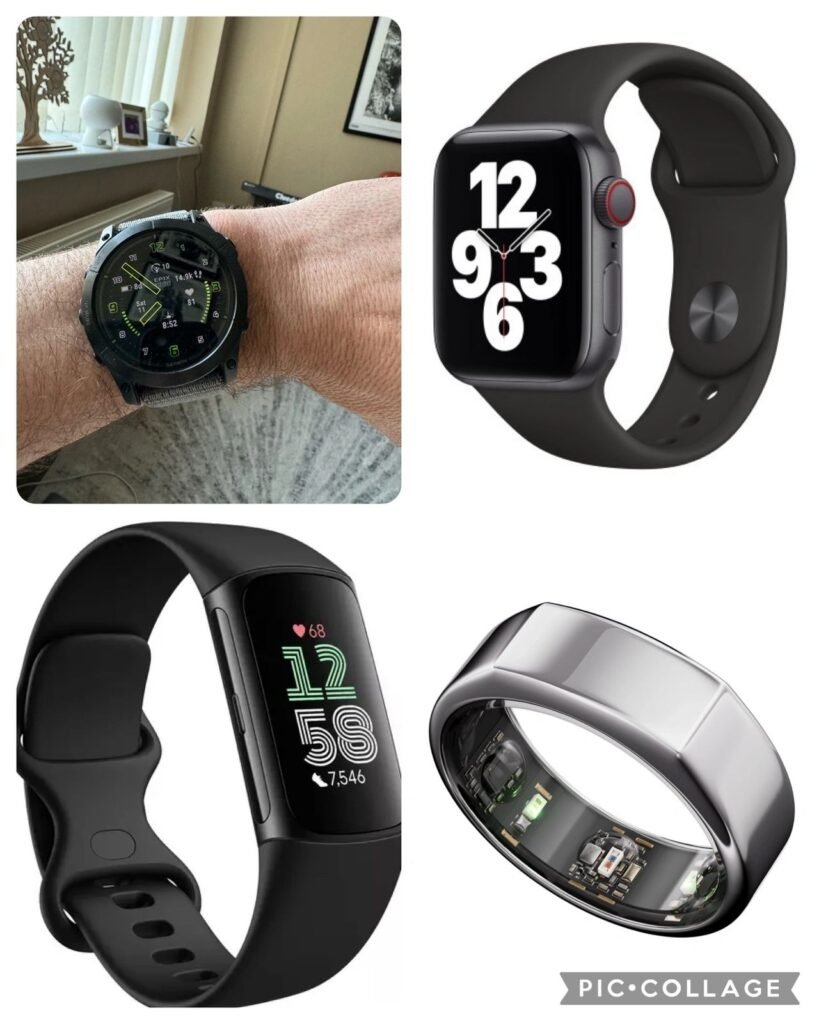
The good news is whether you want a band, watch or a fitness ring, there’s enough choice so you can generally (not completely, differences below) obtain the same metrics from either device. Unless you have a specific need, you’ll generally get by with whatever wearable you choose.
All mainstream wearable devices require you to download and engage with their corresponding app, in order to obtain and analyse the data.
Fitness rings
These slot firmly into the fitness tracker section. You’ll see below, they’re not loaded with the capabilities of a smart watch, they can’t be without a screen.
These are generally a newer technology and gaining popularity. You can extrapolate intricate data whilst still wearing your daily driver watch. Some people enjoy wearing a classic watch and a fitness ring serves it’s purpose. Most of the popular and well reviewed fitness rings don’t come with NFC contactless payment technology in built or GPS
Fitness ring pro’s
- You can use one whilst still wearing a classical watch.
- All the mainstream tracking basics are here, along with some additional advanced tracking metrics listed above
- The finger placement lends itself well to achieving one of the more accurate methods of tracking.
- Light and comfortable
- Compatible with Android/Apple
Cons
- No onboard screen to interact with. It’s all found on the app
- With all sensors turned on lasts around 3-6 days depending on brand (there aren’t many)
- The most popular brand mentioned below runs a subscription service
- No NFC payments on the most popular brands
- No built in GPS
- Pricey for what they are (averaging around £350/430 dollars) and many fitness watches/bands can be considerably cheaper for the same or better features.
Fitness ring popular brands
- Oura Ring (subscription model) are the market leaders
- Ultrahuman Ring
Fitness ring summary
As I stipulated above, this technology is still fairly new. You’ll get a handful of other brands (rumour has it that Samsung are working on one), but the above two are the most well known and reviewed. In this fitness tracking world, there’s a considerable amount of junk out there, so I’d always stick to well known and reviewed products.
Fitness rings aren’t for me, but I have a few friends who wear them and love wearing their daily driver watches too.
What about Whoop Bands?
This feels an appropriate time to slot in a quick few lines covering Whoop Bands. They have a very similar functionality to a fitness ring, excluding the glaringly obvious, being wrist worn. They won’t be equipped with GPS, NFC and a screen. All interaction is also via the app.
There’s no screen on these and battery life/metrics are very similar to fitness rings. You’ll also be paying a hefty subscription model.
There are many die hard whoop users. If a Whoop is suitable for your needs then go for it. I’ve seen too frequent reviews questioning their accuracy and I’m not a fan of subscription models.

Smart watch vs fitness tracker basics
Before climbing over the trenches into the smart watch vs fitness tracker war, there’s a ground rule to grasp.
Generally speaking, fitness wearables (bands are generally in the fitness camp only) can be split into two distinguishable categories. They say you can’t serve two masters, in this case it’s mostly true. At the highest level, the main difference between smart watches and fitness trackers is:
Fitness trackers
- These can be defined as wearables with the primary benefit or fitness tracking and with some (inferior) smart capabilities..
Smart Watches
- These are the yin to the above yang. Smart watches are primarily geared towards fantastic smart capabilities and secondary fitness tracking capabilities.
Fitness Wearable Competition
You’ll observe the internet littered with disputes between Apple, Samsung and Garmin. The lines between the three are certainly converging and for the company that masters the dark arts of combining fitness and smart functionalities, there’s market gains and profit to be made. In the here and now it’s an apples and pears scenario.
The consumer has to choose what their priorities are and purchase according to need. That need is best served by research. I have friends who own smart watches and obtain all required for fitness goals and vice versa. One of my best friends runs a 2:50 Marathon and wears A Samsung watch.
We’re now venturing into the fundamental differences covering a smart watch vs fitness tracker. the caveat, some do venture into each others lane and this is a more generalised pros and cons comparison. As always- research:
Smart Watch Pro’s
- Usually full OLED screen market leading displays
- Calls on wrist, well equipped app stores and replying to messages on the wrist. Envisage a phone on your wrist that’s pretty much a smart watch. They can even control your phones camera for a perfect remote shot and can control various appliances and devices.
- Options on most (with a data plan, they can work independent of the phone) leading smart watch brands.
- Modern smartwatches from industry leaders (Apple/Samsung and others) have excellent fitness tracking tools. They even cover off many advanced/specialist metrics listed above, but still fall short of high end Garmin’s.
- pin point dual band for the Apple Watch Ultra
- For paying with your watch and storing tickets, store cards, airline tickets etc.
- If the smart watch doesn’t contain a specific fitness function, you can find a fitness app to bridge the gap, albeit at a one off cost/subscription.
con’s
- Battery life on the most fully fledged smart watches is a measly 1-2 days.
- Messages, calls, emails… the list is endless. Personally, I don’t need a fitness wearable for this reason. This may be in the pro category for you.
- If you download apps for additional fitness metrics, your metrics are spread out over multiple sources. You’ll be required to constantly access multiple apps. There’s more than likely going to be a one off or subscription fee to the app.
- Basic fitness trackers are cheaper than smart watches
- f you’re an android user, the only purpose an Apple Watch fulfils is a paper weight. It won’t work on Android. Likewise, a newer Samsung watch won’t work on IOS. There are some smart watches which are cross platform, but you’ll get the best features sticking to your operating specific brands.
- Due to battery constraints, if you’ve got your eye on serious endurance events, you’ll need a dedicated fitness watch.
Smart Watch popular brands
Apple Smart Watches
By far has the largest share of the smart watch market. They own a staggering 31% of market share (Q4 2023). In fact, it’s the highest selling watch in the world- mechanical or smart. If you’re with IOS and want a smart watch, I can thoroughly recommend an Apple Watch.
I’ve owned many. Apple has a few watch sizes and models, ranging from the Apple Watch SE model to the flagship Apple Watch Ultra (they have their sights set on Garmin’s market – exciting for us consumers, competition breeds innovation and Apple has been stagnant for too long).
Huawei Smart Watches
Next in line with 10% market share. This mostly consists of Asia due to the google ban (from may 2019). Huawei watches are known for their excellent battery life (go far beyond the average) and accuracy, but the google issue is insurmountable for most. It’s a shame, as my wife owned a P30 Pro phone and it was excellent.
Fire – Boltt
Hold 8% of the market and are an Indian Smart Watch Brand.
Samsung Smart Watches
Up until Q1 23 Samsung held 9% market share. They lost that crown and haven’t regained it since. That said, for smart capabilities they’re on par with Apple, still popular have very similar sensors.
There have historically been questionable health and fitness accuracy issues with Samsung watches. In a similar vein to Apple, there’s plenty of models on offer.
Other Smart watch Brands
Other Smart watch brands worthy of a look are the Google Pixel Watch (they now own Fitbit too), Ticwatch, and nothing watch. This list isn’t exhaustive, but these are some of the best.
Smart Watch Summary
A smart watch can help you reach your goals and provide 90% of all the metrics you’ll ever need. I wore an Apple Watch for many years and was a happy customer. At that time it served its purpose and was a thoroughly useful tool in tracking performance.
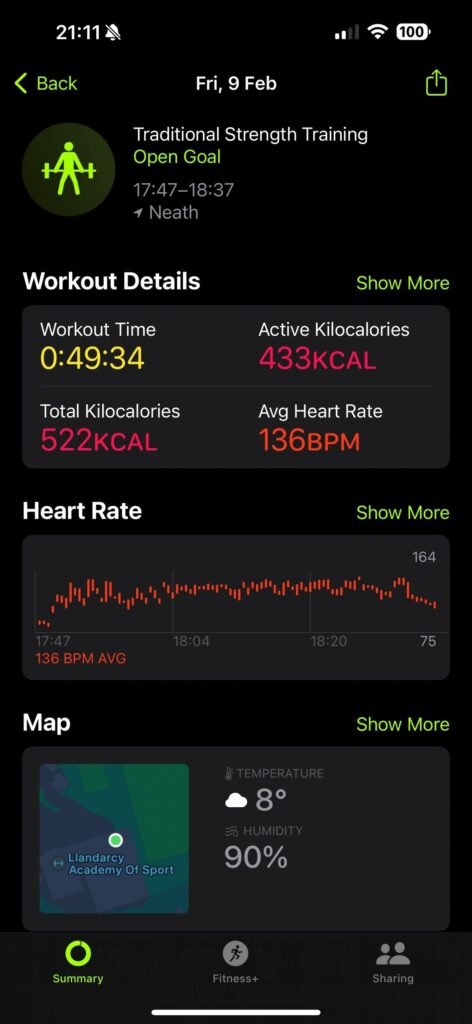
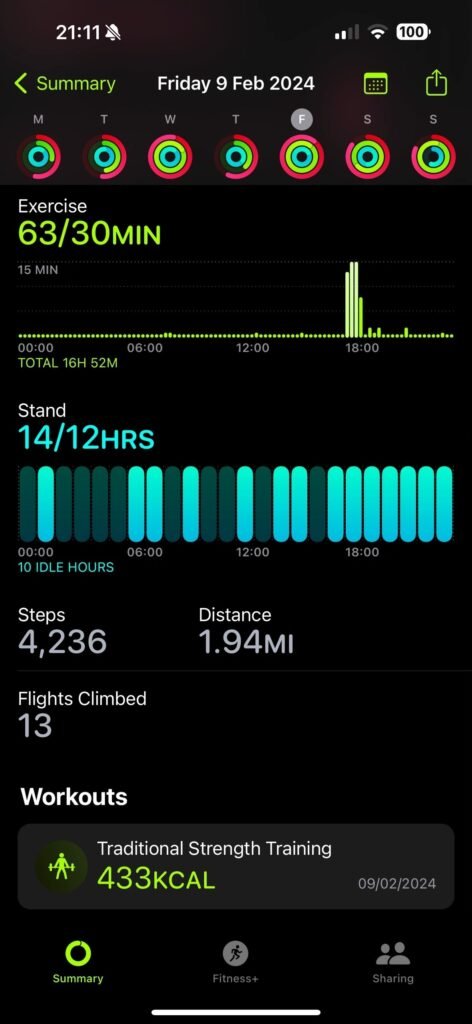
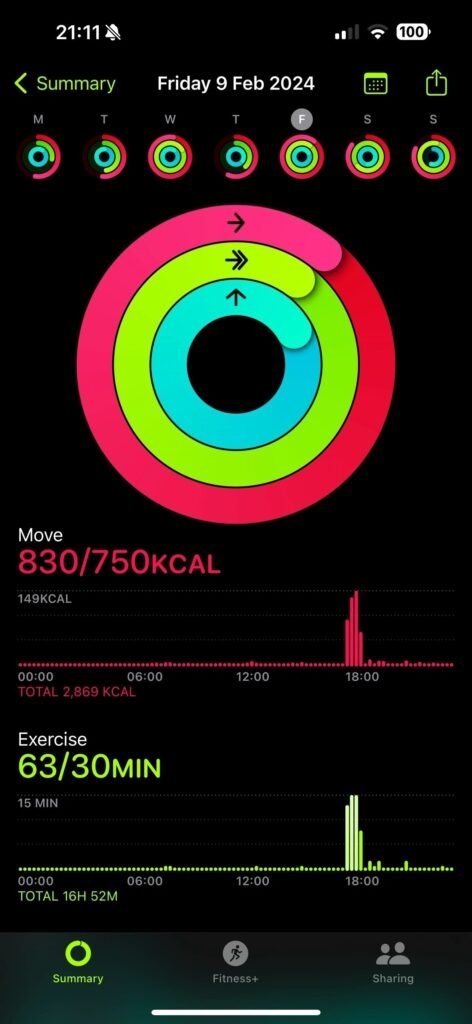
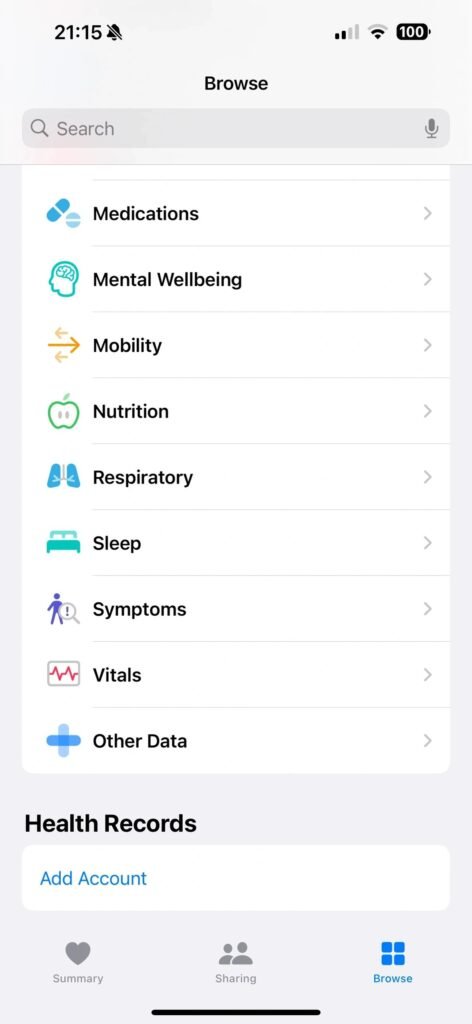

Pro’s of fitness trackers
- Some watches can last for weeks with heavy activity use. They’re capable of multi day endurance event recording without the need for a battery back pack. This is model dependant, but lengthy battery options certainly exist.
- With long battery life are starting to gain popularity.
- Capable of a huge amount of health and fitness metrics. The top end watches have all the basic and advanced fitness features covered.
- Some models have flashlights built into them. you’ll never know how useful this is until you’ve experienced it. It’s a life saver during a 3am bathroom visit. Some smart watches do contain torch functionality. instead of a dedicated flashlight, the screen illuminates.
- Can be purchased in fitness band form if that’s your preference (albeit fitness bands generally last around a week battery wise).
- Most new models come with NFC capabilities if you’re with a compatible bank (not as wide spread as Apple, Google or Samsung Pay).
- No requirement being married to Apple or Android – most purebred fitness trackers are compatible with both operators.
- You can still receive call and message notifications on the watch. On Android only and watch model dependent, you can send limited pre determined replies. Wiith Apple you can’t, being the walled garden it is.
- Route planning and tailored training/coaching plans.
- No need to download additional apps
- Generally cheaper than smart watches, unless you’re going for high end models.
- You’ll often find supporting accessories with popular brands – body fat scales, chest heart rate straps, biking equipment etc.
- Doesn’t feel like a glorified phone on your wrist (again, a pro for me and this may firmly be in the con category for you).
Cons of fitness trackers
- Lacking in smart watch capabilities.
- Top end models are extremely expensive.
- Even more danger of an unhealthy/obsessive relationship with metrics and ensuring all is looking positive at your fatigue expense.
- App stores are subpar compared to smart watches.
- Some fitness watches come with MIP displays (memory in pixel) screens. This is a reflective LCD screen. Two advantages, battery and readability. This screen doesn’t look nearly as visually appealing as an OLED/AMOLED screen and is more difficult to read indoors (a backlight is equipped to bridge this shortfall). The industry seems to be moving away from this technology now that OLED screens are becoming more power efficient.
- Optical heart rate tracking can be iffy on some brands (see further reading below). It has an excellent reputation on Apple and Huawei watches in particular.
- Too much choice. Not only in brands, but the variety in some brands (Garmin) is astounding. I’d highly recommend further research prior to purchase and can’t labour this point enough.
- Whilst improvements have been made, the phone app isn’t as seamless as an Apple or Samsung experience. Sites can go down and that’s the last thing you need on a marathon race day.
Fitness watch popular brands
Pure fitness watch/bands brands is generally a two horse race.
Garmin fitness watches
You’ll rarely see a competitive endurance event without observing a Garmin on a wrist. Garmin have a reputation as being the serious athletes best friend. Over the last couple of decades, the once GPS only tech company has created a serious stamp of authority within the athletics world.
The hardware within the recent watches is generally on the more accurate side. The watch (fitness band available too) options are staggering and cater for all types of needs, build models and sizes. Garmin’s range from basic models up to luxurious time pieces.
Garmin Connect (app) has improved during recent times, but frustratingly is prone to outages and funky glitches.
Fitbit trackers
These also come in a wide range of models (nowhere near as extensive as Garmin). They were hugely popular in years gone by. As smart watch technology has caught up, their market share has dwindled. As referenced above, Google has recently acquired the brand and is slowly integrating it’s services into these trackers.
Fitbit is the brand with the most band model trackers. These range from basic step tracking bands, all the way up to fully fledged advanced trackers.
Fitbit accuracy (particularly optical hr tracking) still gets a bad wrap within the review world and the recently released Fitbit Charge 6 is no different.
I will highlight that Fitbit keep their ‘pro’ tracking metrics behind a paywall known as Fitbit premium. You’ll be paying a monthly fee to access this. Although a purchase of a new device often comes some free Fitbit Premium months.
The data on the Fitbit app is easier on the eye and more user friendly than Garmin’s offering. Garmin’s is adequate, it has a steeper learning curve.
Other Fitness tracker Brands
Amazfit and Coros and up and coming brands. These pose a direct threat to Garmin’s dominance and have been receiving generally positive reviews. It’s the same as the Apple Watch Ultra situation, this is great for us as consumers. Polar and Suunto are established in the fitness watch market, but have lost market share over the last few years.

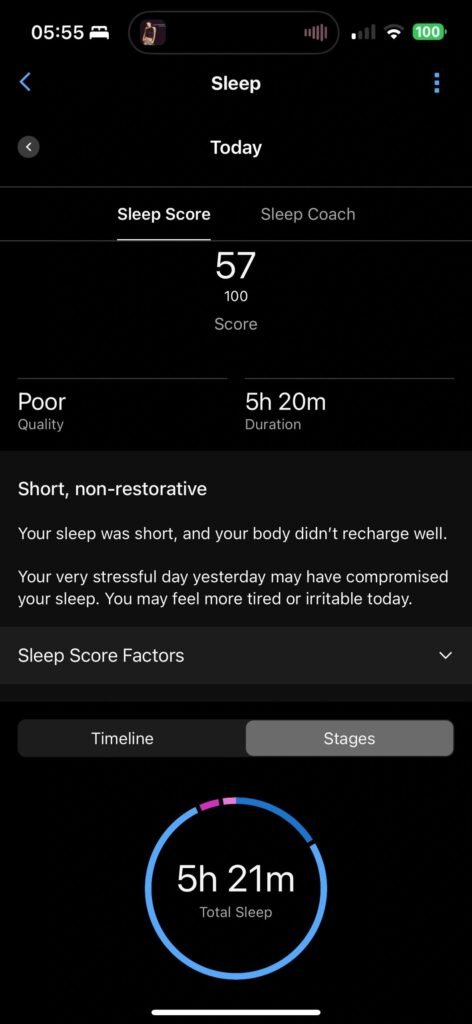
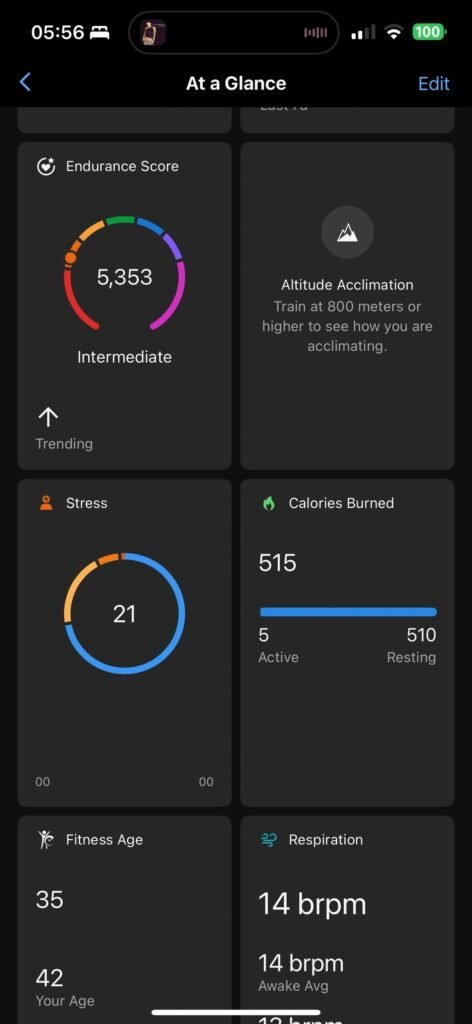
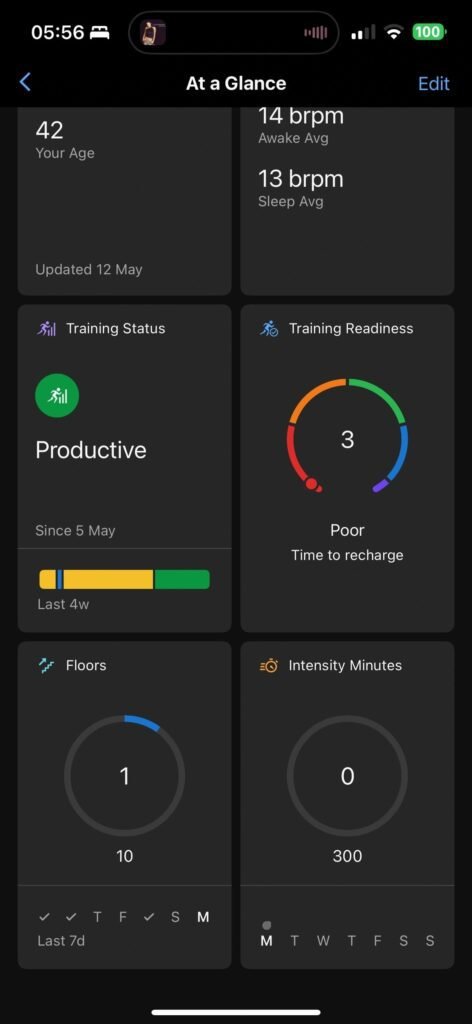

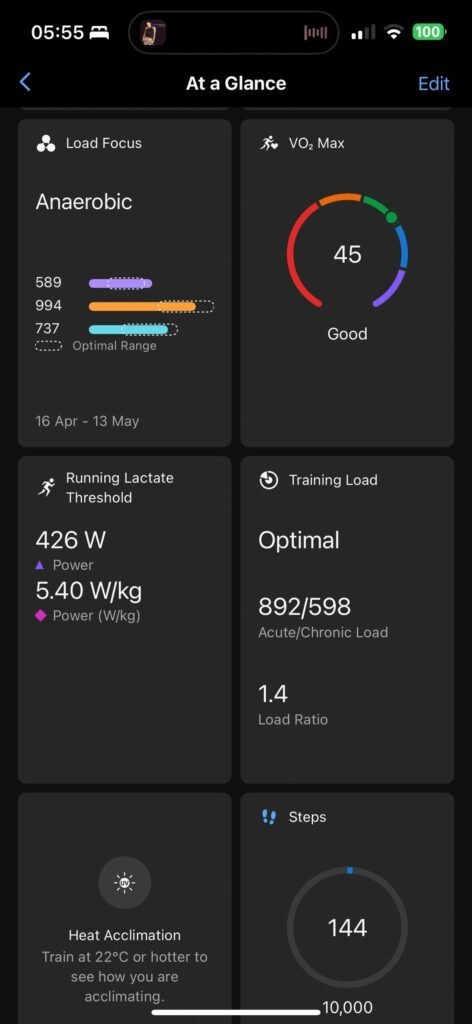

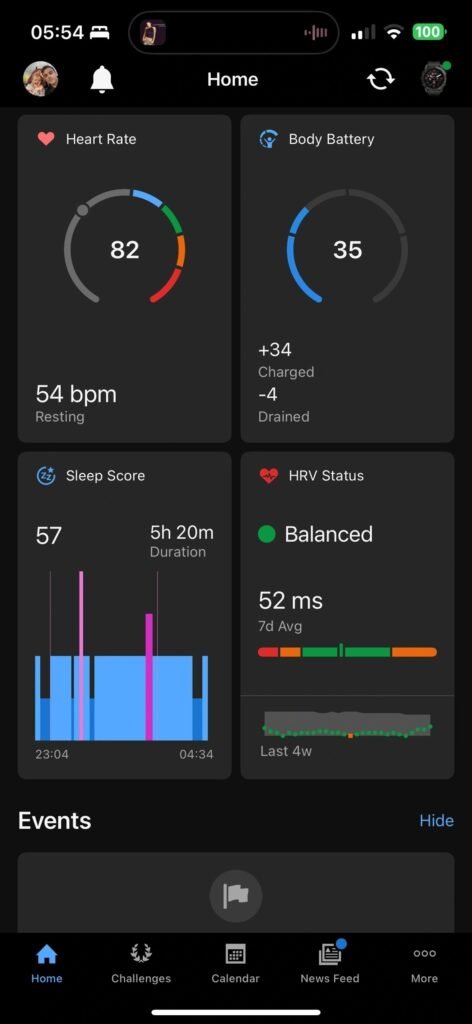
I haven’t used Fitbit in years, but a quick google search will familiarise you with it’s app and what you can expect.
Do you need a fitness wearable?
As with most things in life, a perfect choice rarely exists.. A dedicated fitness wearable will serve you well if you don’t want a smart watch on your wrist and want more variety of choice.
Depending on your fitness needs, you’ll find a more tailored option here. Perhaps you want to keep it simple and track your steps, get some heart rate and general trends information? Or you want to go all in with a sapphire screen, titanium large model which is equipped to do everything? There’s a model for you too. As I’ve advised, picking your brand and model requires further research in order to ensuring your needs are met.
Further Fitness Wearable Information
I’d recommend the below YouTube pages for further assistance in picking the right watch for you. All of these content creators are dedicated to their craft and independent. They provide the best and detailed advice on every popular fitness wearable out there.
DC Rainmaker
DesFit
Chase the Summit
The Quantified Scientist. This is the most comprehensive and unbiased channel for smart and fitness watch performance via scientific analysis.
What fitness wearable do I wear?
I’ve owned many over the years. I started with a Fitbit in 2015, moved to Apple Watches and now use a Garmin Epix Pro. My reasons are:
I’m not a huge fan of multiple wrist notifications (seeing a call come in on the watch and a text message is just fine). I don’t need to interact with a watch in a similar manner to a phone.
- Battery life is paramount to me in addition to GPS accuracy. I charge my device once a fortnight.
- I love hiking in unfamiliar terrain and can load a route up on my watch and follow it.
- I enjoy the mapping capabilities, NFC contactless pay (I’m with a compatible bank)
- Being a little clumsy, the sapphire screen and titanium build is perfect for me.
- Interacting with one Garmin free app is important
- The flashlight has unexpectedly become a great tool
- Cellular connection isn’t hugely important to me.
- I like to time tabata or HIIT workouts on the watch and prefer the button set up
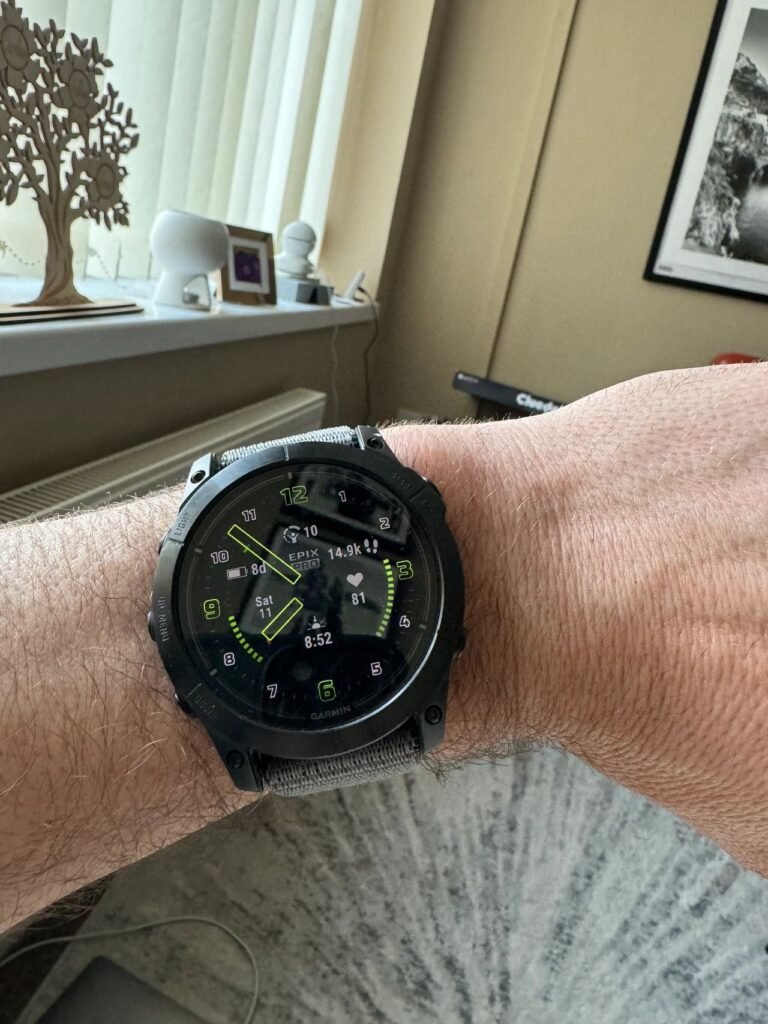
Conclusion and closing thoughts
We’re all unique. This watch is an individual choice in accordance with my needs. To understand this, I researched and I’d urge you do the same. This watch will be overkill for many of you.
I’m excited to see what the future brings in the wearable world and if something comes along that’s more suited to my needs, I’d jump ship from Garmin in a heart beat. Don’t be married to a brand, but your needs as a consumer.
I hope this introductory article into the world of health and fitness wearables has been useful. I hope it’s at least assisted in making your thought processs clearer about whether you need a fitness wearable. If you decide you probably do, I hope further insight was gained within the smart watch vs fitness tracker arena.
If you don’t already, I’d be hugely grateful of an email subscription to my site. You’ll be notified when new posts arrive. I aim to publish 3 posts a week.
Thank you very much for reading.
Chat soon,
Matt.


4 thoughts on “Do you need a fitness wearable? smart watch vs fitness tracker”